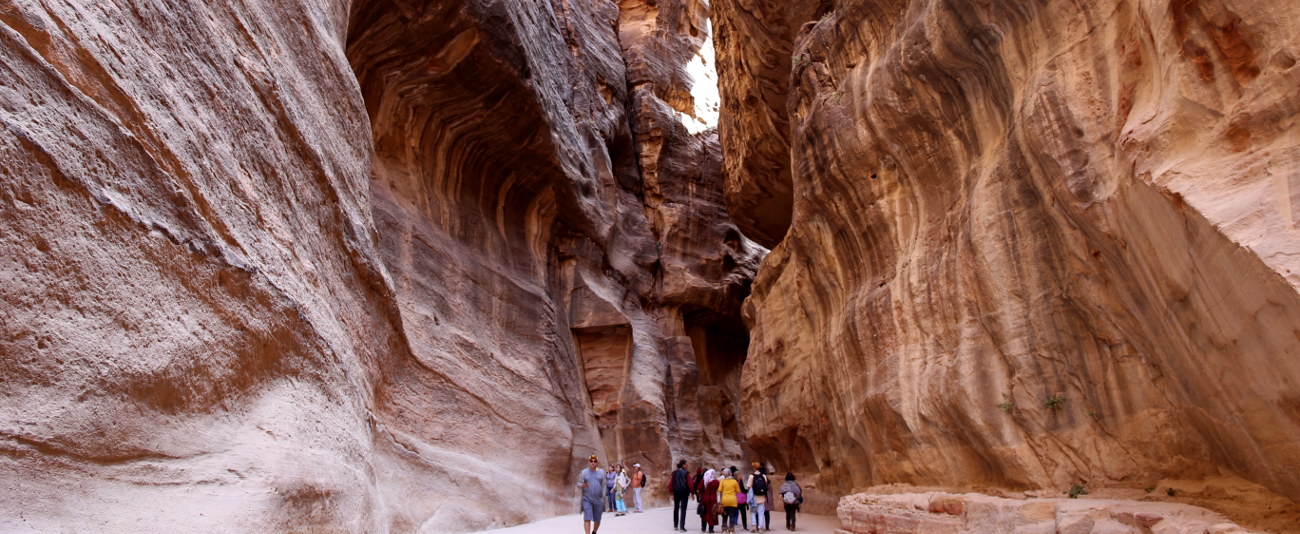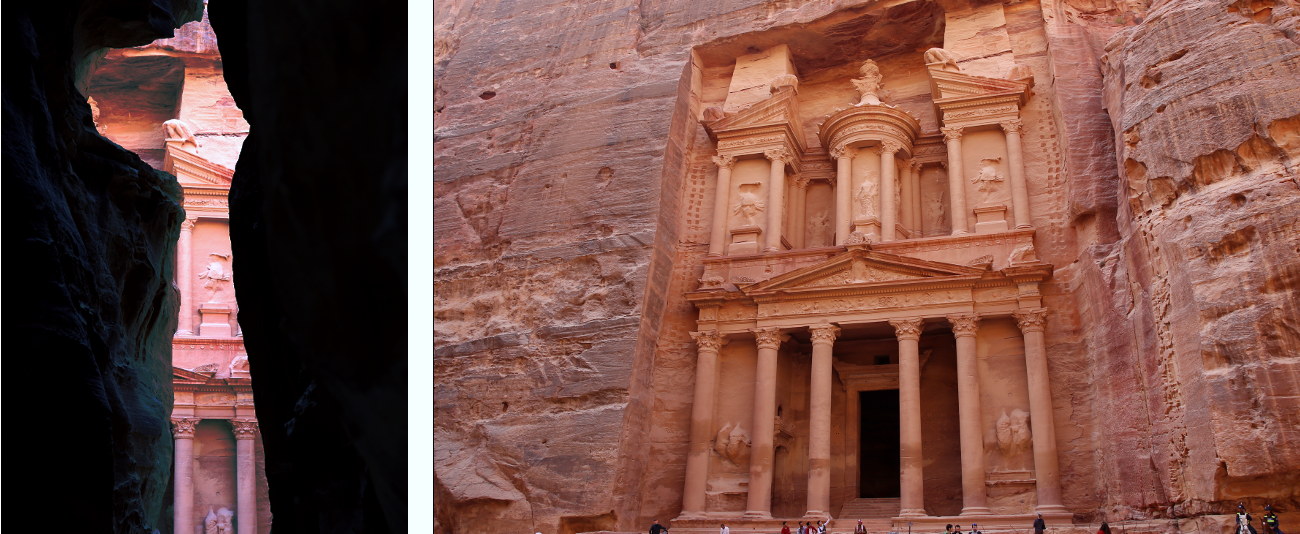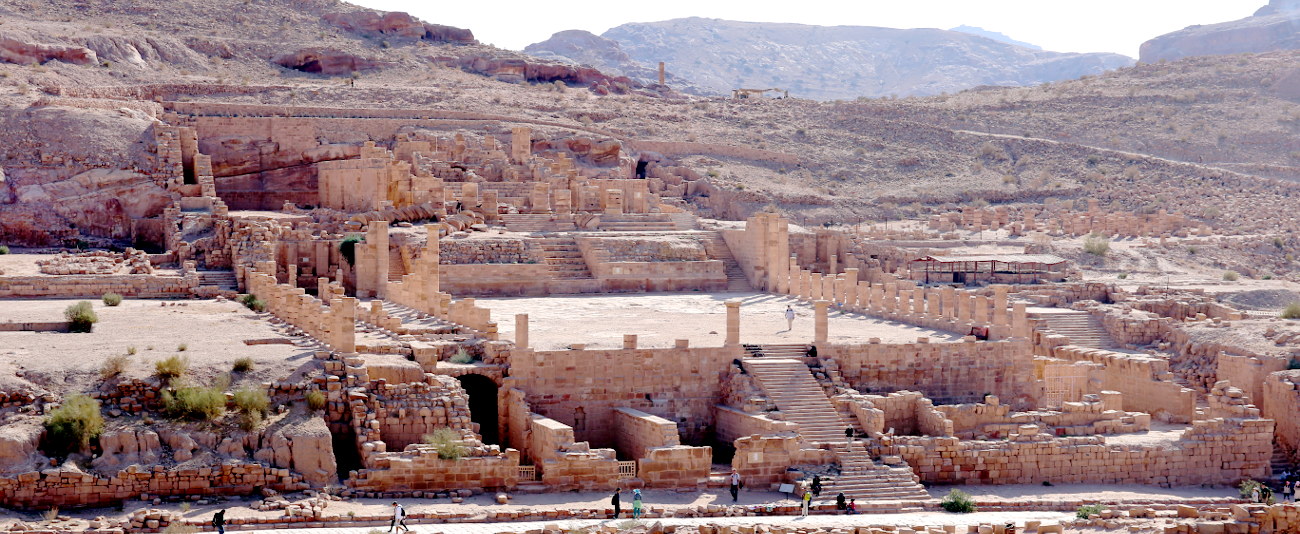The rock city of Petra
The rock city of Petra is the flagship of Jordan and is even one of the seven wonders of the modern world. What many don’t know: The city covers a huge area. Within two days I walked almost 50 km. (Scroll all the way down for my video series)
Protected by the 1.5 km Siq
If anyone has heard of Jordan, it is mostly in connection with the rock city of Petra – the ancient capital of the Nabataeans. From about 300 BC the city was inhabited and was finally abandoned about 600 AD. A large part of the city was carved directly from the rock face and is still preserved today. The city of Wadi Musa is located directly next to Petra and contains everything necessary like hotels, supermarkets and restaurants. By bus it is roughly 3.5 hours from Amman (JETT-Bus 10 JD, November 2017). The bus stops right next to the Visitor Center, so you can start right away. The entrance fee to Petra was included in my Jordan Pass.
About halfway between Petra Visitor Centre and the entrance to the Siq, look out for three enormous, squat monuments, known as Djinn Blocks or God Blocks. Standing guard beside the path, they take their name from the Arabic word for spirit, the source of the English word ‘genie’. Other than the fact they were built by Nabataeans in the 1st century AD, little is known about their why or wherefore.
But wait, the access to the actual terrain leads through the Siq (en: gorge), which is about 1.5 kilometers long. One walks along the former water pipe of the Nabataeans, which was probably made of terracotta pieces and plastered with well… plaster ;-). A very advanced technique for the time.
The Siq itself is very worth seeing and consists partly of different rock types, which make it a very beautiful gorge. Theoretically there is the possibility to be “driven” by carriage or donkey. Personally I found this completely unnecessary, because it was not exhausting, if you wear proper shoes. Moreover, the carriages are really annoying, because the Siq is only three meters wide in some places, not to mention the poor animals that are driven by whips.

Links: The Siq is very busy, now and then you have to avoid carriages. Right: Water pipe of the Nabataeans.
Khazne Faraun: treasure chamber or burial chamber?
The Siq ends directly in front of one of the highlights of Petra and surely the most famous building: the treasury Khazne Faraun. But the name is deceptive, because in reality it most likely is a grave. On the pictures it is hard to grasp that Khazne Faraun is over 40 meters high. The stone is very well preserved, so that even decorations are recognizable. Unfortunately, it is not possible to enter Khazne Faraun, but you can get close and see that the rock inside consists of many different layers. Since almost all pictures from Petra are depicting Khazne Faraun, many believe it would be the only building, but stop: There is still a lot to see.
The Non-Roman Roman Theater?
From Khazne Faraun we continue to the right along high rock walls to the actual area and to the city center. From a distance I did already see the Roman Theater, which has seats for 7,000 spectators. Also the theater’s name is misleading, because the theater was carved out of stone by the Nabataeans themselves before the Romans conquered the city. Probably some older graves were converted, which can still be seen today in small caves on the theater walls.
Away from the masses: High sacrificial place
Only a few steps back towards the treasury are stairs on the right hand side. They led me to the High Place of Sacrifice and a viewpoint from where you could see the Street of Facades and the Royal Tombs. I descended another way, which led past further ruins. Among them are the Garden Temple, the Lion Statue and several graves. There were hardly any other tourists. Even if everything sounds as if it was very short and compact, it took me several hours to reach the Temple Qasr Al-Bint. Near the temple is an unfinished grave and from it archaeologists concluded that the masonry work was done from top to bottom.
A break in the city center
After arriving in the city center, I took a break before I continued my way from the temples along the Colonnade Street.
There are also the Byzantine Church, the Great Temple and the Nymphaeum. The Nymphaeum was once a big well, which was supplied very tricky by the Nabataeans with water.
Petra consists mainly of graves
And the day was over. Since I knew that the area was relatively large, I had planned two days in Petra (in retrospect, one day too little). On the second day I took the route along the wall of the royal tombs, past the grave of Sextus all the way up to Al-Khubtha, which consisted mainly of stairs, which were carved from the stone.
The view from Al Khubtha
Even if the ascent was exhausting, Al Khubtha was totally worth it. From here I had an amazing view of almost everything I had already visited – even Khazne Faraun. Unfortunately, there was no other way for the descent, so I had to take the same way down. In general, I should say that not only the ruins alone, but also the landscape are worth seeing.
The monastery up high
That not only the ruins are worth seeing was also shown during the last part of my tour: the ascent to the Al-Deir monastery. Over 800 steps led me to the top and many tourists use the option to ride a donkey up there. That led to the fact that I had to avoid donkeys again and again and therefore I even fell down. Unfortunately, the animals didn’t seem to be very happy to me, because they were driven by whips. When I finally made it, I was rewarded not only with the monastery, but also with another amazing view.
The ascent took about 45 minutes, but I only took very short breaks for drinking water. At the top I took a longer break to climb up and enjoy the view.
All in all I “ran” 50 kilometers in the past two days, in retrospect three days would have been the better choice. Despite the limited time, I saw everything I wanted. My hiking shoes were very important, they are non-slip and protected me from falls and broken feet at least twice.
Don’t Panic!
My Petra Video Series on Youtube












 Backpacking is my favourite "hobby" and here I write tips, tricks and reports about it.
Backpacking is my favourite "hobby" and here I write tips, tricks and reports about it.